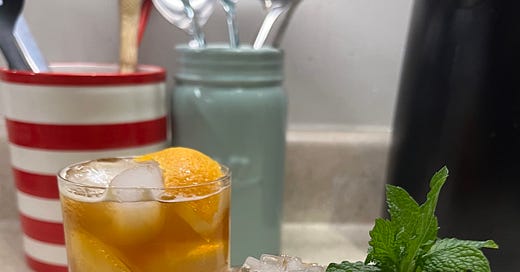Believe it or not, even I have a limit when it comes to bitters. I learned this a few weeks ago, when my boyfriend and I visited Billy Sunday, an amazing bar in Chicago focused on amari, or Italian bitter herbal liqueurs. We sampled a flight of amari that ended with Fernet del Frate, a fernet that Tempus Fugit Spirits released in 2013. The first sip smacked me with menthol and pine; it was intense. I couldn’t get past how astringent and medicinal it was. My boyfriend, who’s already obsessed with the more popular Fernet-Branca, loved it. I let him drink most of that one.
Fernet is one of the more intense amari, defined by its prominent menthol flavor and use of botanicals like saffron, myrrh, cardamom, and rhubarb. It tends to be bottled at a higher proof and served as a digestif. If you know any fernet, you know Fernet-Branca, which is popular as a shot among bartenders and with Coke in Argentina. (In fact, many fernet fans don’t even know that it’s a much wider category than just Branca.) Along with the strong menthol, there’s a light coffee/dark chocolate bitterness to Fernet-Branca.
Fernet is also unique among amari because it shows up in a few classic cocktails. There’s the Toronto, an Old Fashioned riff that was first published in the 1922 book Cocktails: How to Mix Them as the Fernet Cocktail. And there’s the Hanky Panky, a Martinez riff created by Ada Coleman at the Savoy Hotel sometime in the early 1900s. These drinks, especially a Hanky Panky, tend to be my preferred way to consume fernet, since I don’t love it in large doses.1
Obviously, fernet fits perfectly with the Beta Cocktails mission. The book even includes a rare fernet-based cocktail, from co-author Maks Pazuniak. The Fernet Sling is pretty much a fernet riff on a Collins, with lemon juice, demerara syrup, and a secret kick of Carpano Antica sweet vermouth to round out the bitterness. (I don’t understand the difference between calling this drink a Collins or a Sling, other than the name.) Maks’s note in the book really hypes it up — he writes that it tastes like “pine tree-grasshopper-toothpaste soda,” which, have you ever seen a more vivid description of a flavor?
When I first saw the Fernet-Branca/Carpano Antica combination in this cocktail, it reminded me of another drink I’d read about: the Prizefighter No. 1. This drink was the first in a series of smashes that Nicholas Jarrett made at the Brooklyn bar the Clover Club.2 It features most of the same ingredients as the Fernet Sling, just in different proportions and forms: Fernet Branca, Carpano Antica vermouth, lemon, and simple syrup with some mint leaves to make the Fernet pop. As in the Fernet Sling, the Carpano Antica seemed essential, a hefty counterpart to that wallop of bitterness. Obviously, I had to compare them both.
Fernet Sling3
2 ounces Fernet Branca
3/4 ounce Carpano Antica
1/2 ounce lemon juice
+1/4 ounce demerara syrup (2:1)
Soda
Shake and strain into a Collins glass, top with soda water; garnish with a fat orange twist.
By Maks Pazuniak
6 mint leaves
3 lemon wedges (each 1/8 of a lemon)
3/4 ounce simple syrup (1:1)
1 ounce Fernet-Branca
1 ounce sweet vermouth (preferably Carpano Antica Formula)
1/4 ounce fresh lemon juice
Pinch kosher salt
Mint sprig (for serving)
Muddle 6 mint leaves and 3 lemon wedges in a cocktail shaker with 3/4 ounce simple syrup (1:1), pushing firmly enough to express juice but not destroy the mint. Add 1 ounce Fernet-Branca, 1 ounce sweet vermouth, 1/4 ounce fresh lemon juice, and a pinch kosher salt. Fill with ice and shake until exterior is chilled, 10–15 seconds. Double-strain, using a cocktail strainer and a fine-mesh strainer, into a rocks glass filled with crushed ice. Garnish with a mint sprig.
By Nicholas Jarrett
Menthol is still the most prominent note in the Fernet Sling, but there’s a depth here that I don’t get as much in Fernet Branca on its own. It’s earthy, savory, maybe even lightly smoky. (Not quite grasshoppery, though.) I don’t notice the acid of the lemon, and it’s not obviously sweet from the demerara or vermouth, but it does feel a bit polished. I don’t think I could drink one of these in full, but my boyfriend could — he told me it tasted like “fernet made to sip on.” I much preferred the Prizefighter, which tasted like the best, most refreshing minty lemonade. I already love the lemon-mint combo of a Whiskey Smash, and the extra depth of mintiness from the fernet took this to another level. The drink wasn’t noticeably bitter, but it did lean sour, presumably from the use of lemon wedges and juice.
Thinking back, I wonder if there’s a way to merge these two drinks — an Improved Fernet Sling with more lemon and vermouth, and maybe even fresh mint, that’d be a more refreshing long drink. Maybe I’ll toy around with a recipe and include it in a future newsletter.
For now, you have another Cynar drink to look forward to next week — from the best-written recipe in the whole book.
One exception: The fernet from Letherbee, a distillery in Chicago. It tastes much more like coffee and dark chocolate, and I love it on the rocks as a digestif.
If my memory is right, the Clover Club was the first proper cocktail bar I ever visited. I was an intern in New York City and popped in for happy hour one Friday; I got a Martinez, which was a very bracing introduction to spirit-forward cocktails. (I love Martinezes now, though.)
From Beta Cocktails by Maksym Pazuniak and Kirk Estopinal, 2011.




